15 Apr How to Handle Yourself During a Kitchen Remodel
In the early stages of planning for a kitchen remodel, it’s fun to spend time researching and gathering ideas. What is the best design, what new products will you need, what colors should you choose? You’ll be anxious to know what the end result will look like. But perhaps the most important part to plan is how to handle yourself during the kitchen remodel.
Bringing your kitchen from its current state to the beautiful new space you’ve dreamed of takes a lot of work, time, grace, and patience. There is demolition, dust and disruption to contend with. Unless you’re undertaking the project yourself, there will also be contractors and installers taking up shop in your home. Although you hope for the best, a snag or two will pop up during the process that will need your attention to problem solve. At times, you may even wonder why you’ve chosen to undertake the renovation at all! But these helpful, calming tips will help you feel more organized and better prepared to face this momentary disruption in your home.
Temporary Headquarters
Designate an area in the home that will serve as a substitute kitchen (aka Temporary Headquarters.) Areas to consider are the garage, den, basement, laundry room, mudroom or even the patio, if it’s enclosed. Wherever it is you choose to make your temporary kitchen, ensure there is ample electricity for the appliances you’ll be using. Utilize a rolling cart for food prep and bookshelves for dishes and canned goods. Make sure you have enough space to stash everything you’ll need during this period.
Having a sink nearby for cleanup is optimal, but don’t be afraid to wash dishes in the bathroom. A temporary cooking area will serve its purpose long enough to make it through demolition, reconstruction, and the final touches of your remodel. On a positive note, you can view this time as an opportunity to donate or get rid of unused kitchen items and to dine at those restaurants in the area you’ve been wanting to explore.

On the Move
Prior to the start of the demolition, decide what needs to be removed from the kitchen. Consult with your contractor to better understand what the requirements and expectations are. Move out furniture, dishes, cookware, decorative pieces, food items and pantry goods. Grab boxes, containers, baskets and other storage bins to set up camp in your Temporary Headquarters. If appliances are being temporarily removed, consider utilizing them in the substitute kitchen area. To help control the onslaught of dust, hang plastic around the construction area. Although this will not alleviate all of the dust, it will help contain a good portion of it. Your contractor may already have plans to close the area off.
Tracking Progress
 A kitchen remodel process can be a lengthy one. To help ease some of the strain, familiarize yourself with what to expect. Create a checklist and consult with your contractor to gain a better understanding of the steps involved and what the estimated time frames are. Keep in mind that delays inevitably occur due to unforeseen circumstances, and creative problem solving is often required between both you and your contractor.
A kitchen remodel process can be a lengthy one. To help ease some of the strain, familiarize yourself with what to expect. Create a checklist and consult with your contractor to gain a better understanding of the steps involved and what the estimated time frames are. Keep in mind that delays inevitably occur due to unforeseen circumstances, and creative problem solving is often required between both you and your contractor.
Keeping a checklist is a constructive way to track the progress of your project and will also help you to see the light at the end of the tunnel.
Positive Energy
Remember that a positive attitude goes a long way. Remain level-headed and helpful when questions arise and treat your contractors, subcontractors and installers with respect and a friendly disposition. In so doing, you will be rewarded with quality results. Most importantly, keep in mind that the dusty mess of renovation will not last forever. When all is said and done, you will have your home back, your sanity back and a brand new, beautiful kitchen.
For more information on Denver kitchen renovations, contact us. Our design staff is dedicated to making your remodel a success.



